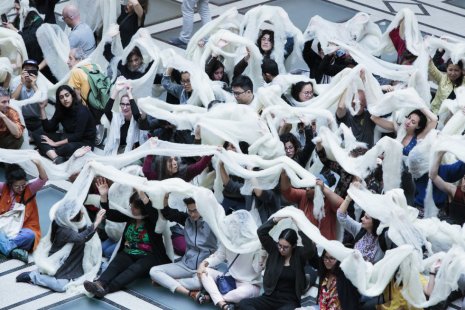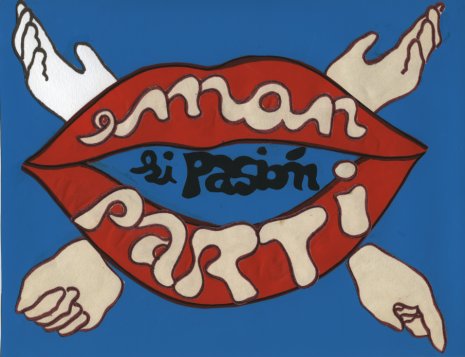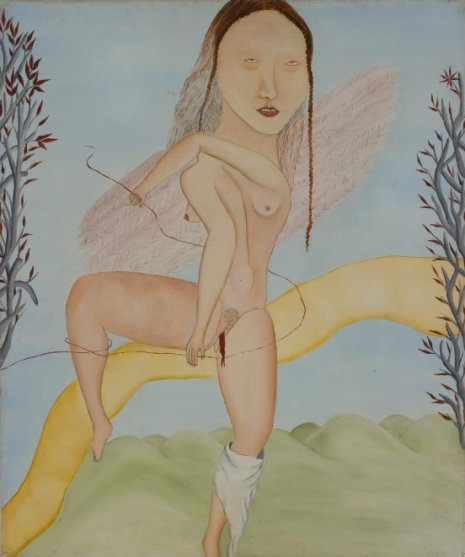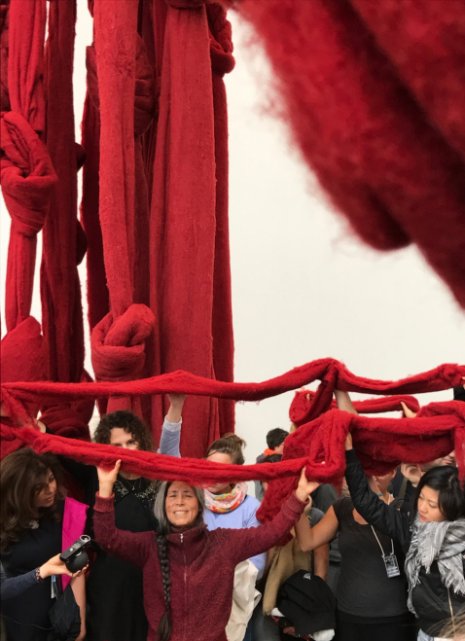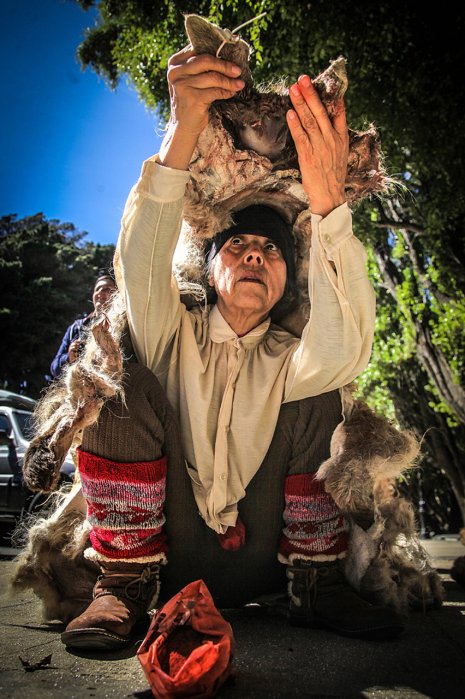Chapter One
Cecilia Vicuña’s body of work, spanning over fifty years, is multi-dimensional and consists of “songs, performances, installations, written works, books, sculptures…” Given her rich web presence, and, this, a particularly busy year for her, in lieu of an interview, we’ve culled a taste of her lucid, inspiring words and a picture of her expansive worldview. In addition to images and videos, you’ll find here, too, a recent video interview (with, for the first time, an English translation.***)
Part of the radical beauty of Vicuña’s work is how it navigates, links, and banishes time and space. Mutable, ephemeral, and beyond categories it is and we wish we could reflect it here as a multi-dimensioned galaxy rather than the necessity of single-file, ‘shepherded’ quotes.
– Irene Borger, Director, Herb Alpert Award in the Arts
Beginnings
“My first work was an offering to the sea, a sea dying from oil, in January 1966. I was in Chile at the time. I created the work, and high tide erased it. My art began by disappearing, following the movement of the waves. Awareness of disappearance gives life to life. I named this act “Arte Precario” (Precarious Art) for its propensity to disappear, giving life. The precarious name created a new space, a category and definition that continues to be valid today…After fifty years I still return to the fertility of that instant, from whence it all comes forth in waves of perception, memory and forgetfulness, in a music of understanding, “a silence waiting to be heard.” I still revisit the methods and principles of its ways in each new work, as if they were all one, and yet different.”
– Herb Alpert Award application, Autumn 2018
“…it began in 1966, when I was maybe seventeen or eighteen in Chile. It began with a vision. Suddenly I saw a word as if it was a living organism. This word opened up to reveal the huge dimension of its emptiness, and the poetic world inside language opened up for me. It is a cosmic dimension, the way language was understood by ancient people for millennia.”
“My work, in the way that I conceive of it and the way that many others interpret it, takes in everything. What I do are songs, performances, installations, written works, books, sculptures; that is, my work is completely multidimensional. Also, I’ve worked with a lot of people from the very beginning. I have founded or been a member of collectives that have now become part of history. At the same time, while I may come from a family of artists, my ancestral roots are ancient, going back thousands of years, in Chile as well as in Europe and Africa. Therefore, my archive is a kind of multidimensional document that involves all of my connections and relationships, even the ancestral ones. The archive is not just something physical that is kept in a box, it’s also all of those relationships."
History of Activism, Feminism
Born and raised in Santiago, Vicuña was exiled during the early 1970s after the military coup against President Salvador Allende and the rise of Pinochet. Her life and work are borne out of this time; her commitment to witnessing, action, and collective practice a reflection of her insight and ethics.
“…in those years there was the same type of confluence or convergence as is happening today. The spiritual, the political, the existential, the ecological; everything was coming together. And that special situation gave you a consciousness of the present, a consciousness of what was possible for us as humanity, as an evolutional leap.”
“…there has always been the idea that the political artist is a square peg just like an ideologue. But there are people like Lucy R. Lippard, who in her essay published in our catalogue mentions my work as a political act of another type: a type of political art that is spiritual, abstract, minimal and doesn’t fit into any existing definitions. It broaches a sensibility that is simultaneously aboriginal and futuristic. In the group of people with whom I work I feel that there is a desire to transform life, to transform the present. Old people, like me, we continue to connect to that and we keep going along the same lines, as if 40 years hadn’t passed by for us.”
– Daniel Borzutsky, “No, No, and No: The Art of Cecilia Vicuña” in New and Selected Poems of Cecilia Vicuña, Kelsey Street Press, 2018, page xix.
“…many of the roots and etymologies of ancient Greek reflect an earlier culture of female creativity, as is the case the world over. The testimony to that is inside the words themselves. It’s a fact that very few languages speak of thought without involving weaving. I’ve been working to dig out all these weaving metaphors because they’ve become invisible. People say, “Oh, I’ve lost the thread of my thought.” Why is that, and who created that metaphor? Was it a weaver?”
Performance
“The great laboratory of my art is the improvisatory, participatory performance, often associated to a site-specific installation, which may take place during several iterations of the “same” piece, in various locations. The performances in the landscape, streets, or museums may involve large or medium sized crowds. These gatherings emphasize the collective nature of creativity, the need to join with others in the quest to transform the world, to bring forth justice, balance and sustainability.”
- Herb Alpert Award application, Autumn 2018
“I think the first public performance I did was in 1970. Before that I was performing without announcement, just on the bus, in the street, at the beach, in the mountains. Whoever happened to pass by could be there, or not. I could perform for clouds and grass, trees and ocean. Before the military coup in Chile there was tremendous freedom because we were still living in the era of the ’60s—that joyous, wild energy. Nobody called them performances; they were events or happenings.”
“…forced by censorship, I became an oral poet. My poems could never see print, never be circulated as books, so I began performing…”
“…nothing is more despised and ridiculed than an indigenous woman. Nothing is more despised and ridiculed than a little piece of thread. I often do performances in the middle of the street, unannounced, where they are not expected, where nobody knows exactly what is going on. Yet there is this mysterious sense by which people are either attracted or repelled. I have woven towns with thread only to discover that these threads have been burned, cut as people are also burned or cut. What is it about the thread that evokes something so deep in a human being that it can either soften you or harden you depending on where your orientations lie? I think, when I do these performances: What am I trying to disrupt? Perhaps it is the vision of ourselves.”


